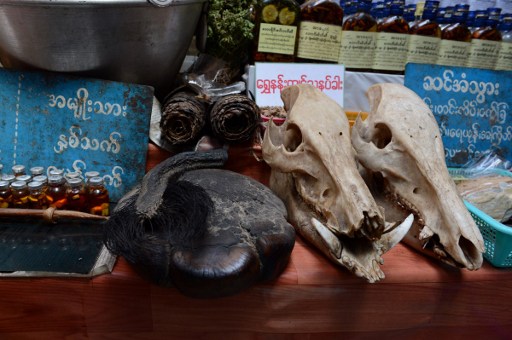by Hla Hla Htay and Caroline Henshaw
Under the shadow of Myanmar’s famed “Golden Rock” punters haggle for the latest traditional medicine cure — slices of skin from the country’s fast disappearing wild elephants sold for a few dollars a square inch.
A set of stairs winds behind one of the Buddhist country’s most holy sites to a maze of shops openly selling everything from pieces of ivory and tiger’s teeth to vials of bear oil.
But there is a new fad luring devotees of traditional medicine.
“Elephant’s skin can cure skin diseases like eczema,” one shop owner, who requested anonymity, told AFP next to a counter brimming with porcupine quills and snake skins.
“You burn pieces of skin by putting them in a clay pot. Then you get the ash and mix it with coconut oil to apply on the eczema.”
He breaks off to talk to a potential buyer, who baulks at the price tag of K5,000 ($3.65) per square inch of elephant skin.
Another young man touting his wares nearby promised a paste made from ground up elephant teeth would “cure pimples and remove black spots”.
“Your face will be smooth and white after you use it,” he said grinning.
Elephant poaching in Myanmar has jumped tenfold in recent years, the government said this week, driven by growing demand for ivory, hide and body parts.
Increasingly carcasses are being found stripped of their skin, the hide used for traditional medicine or reportedly turned into beads for jewelry.
Some of it is sold in local markets, but the vast majority goes to feed neighboring China’s inexhaustible taste for exotic animals.
Myanmar’s wild elephant population is thought to have almost halved over the past decade to around 2,000-3,000.
The animals are killed or smuggled alive to be used in the tourist industry in neighboring Thailand.
“We’re in the middle of a crisis,” said Antony Lynam, regional adviser at the Wildlife Conservation Society.
“If we’re losing this number it can’t be too many more years before wild elephants are gone.”
Weak laws
Elephants are one of dozens of endangered species being trafficked through Myanmar, which has become a key hub in the $20 billion a year global wildlife trade.
Watchdog TRAFFIC claims the country has “the largest unregulated open markets for tiger parts” in Southeast Asia, which experts say also sell everything from African rhino horn and clouded leopard skins to pangolins.
Much of the trade runs through the country’s lawless eastern periphery, controlled by a sophisticated network of criminals who are thought to be armed and funded by powerful “kingpins” in China.
It is lucrative business: in Mong La, on Myanmar’s eastern border, sales of ivory alone are thought to rake in tens of millions of dollars a year.
Hunting endangered animals is illegal in Myanmar, which is a signatory to the Convention on International Trade in Endangered Species of Wild Fauna and Flora (CITES).
But the maximum fine for anyone caught is less than $60, while laws are poorly enforced.
“As a result the number of cases that we see in terms of wildlife crimes are really, really low,” said Giovanni Broussard, regional coordinator at the UN’s drug and crime enforcement agency.
This week the government pledged to strengthen the law on killing elephants and clamp down on the trade in ivory and body parts.
At a regional level, Southeast Asian bloc ASEAN has set up a wildlife enforcement network to stop trafficking and seizures of endangered animal products have been on the rise.
Last month China also said it would ban the ivory trade by the end of 2017.
Still, experts say Myanmar has a long way to go to save its elephants.
“There is a lack of political will and society as a whole is not really interested,” said Vincent Nijman, a professor at Oxford Brookes University who has studied wildlife trafficking in Myanmar for a decade.




